IEEE TRANSACTIONS ON PATTERN ANALYSIS AND MACHINE INTELLIGENCE, VOL. 33, NO. 12, DECEMBER 2011
2341
Single Image Haze Removal
Using Dark Channel Prior
Kaiming He, Jian Sun, and Xiaoou Tang, Fellow, IEEE
Abstract—In this paper, we propose a simple but effective image prior—dark channel prior to remove haze from a single input image.
The dark channel prior is a kind of statistics of outdoor haze-free images. It is based on a key observation—most local patches in
outdoor haze-free images contain some pixels whose intensity is very low in at least one color channel. Using this prior with the haze
imaging model, we can directly estimate the thickness of the haze and recover a high-quality haze-free image. Results on a variety of
hazy images demonstrate the power of the proposed prior. Moreover, a high-quality depth map can also be obtained as a byproduct of
haze removal.
Index Terms—Dehaze, defog, image restoration, depth estimation.
Ç
1 INTRODUCTION
Haze removal1 (or dehazing)
IMAGES of outdoor scenes are usually degraded by the
turbid medium (e.g., particles and water droplets) in
the atmosphere. Haze, fog, and smoke are such phenomena
due to atmospheric absorption and scattering. The irradiance
received by the camera from the scene point is attenuated
along the line of sight. Furthermore, the incoming light is
blended with the airlight [1]—ambient light reflected into the
line of sight by atmospheric particles. The degraded images
lose contrast and color fidelity, as shown in Fig. 1a. Since the
amount of scattering depends on the distance of the scene
points from the camera, the degradation is spatially variant.
is highly desired in
consumer/computational photography and computer
vision applications. First, removing haze can significantly
increase the visibility of the scene and correct the color shift
caused by the airlight. In general, the haze-free image is
more visually pleasing. Second, most computer vision
algorithms, from low-level
image analysis to high-level
object recognition, usually assume that the input image
(after radiometric calibration) is the scene radiance. The
performance of many vision algorithms (e.g.,
feature
detection, filtering, and photometric analysis) will inevita-
bly suffer from the biased and low-contrast scene radiance.
Last, haze removal can provide depth information and
benefit many vision algorithms and advanced image
1. Haze, fog, and smoke differ mainly in the material, size, shape, and
concentration of the atmospheric particles. See [2] for more details. In this
paper, we do not distinguish these similar phenomena and use the term
haze removal for simplicity.
. K. He and X. Tang are with the Department of Information Engineering,
The Chinese University of Hong Kong, Shatin, N.T., Hong Kong, China.
E-mail: {hkm007, xtang}@ie.cuhk.edu.hk.
. J. Sun is with Microsoft Research Asia, F5, #49, Zhichun Road, Haldian
District, Beijing, China. E-mail: jiansun@microsoft.com.
Manuscript received 17 Dec. 2009; revised 24 June 2010; accepted 26 June
2010; published online 31 Aug. 2010.
Recommended for acceptance by S.B. Kang.
For information on obtaining reprints of this article, please send e-mail to:
tpami@computer.org, and reference IEEECS Log Number
TPAMISI-2009-12-0832.
Digital Object Identifier no. 10.1109/TPAMI.2010.168.
editing. Haze or fog can be a useful depth clue for scene
understanding. A bad hazy image can be put to good use.
However, haze removal is a challenging problem because
the haze is dependent on the unknown depth. The problem is
underconstrained if the input is only a single hazy image.
Therefore, many methods have been proposed by using
multiple images or additional
information. Polarization-
based methods [3], [4] remove the haze effect through two or
more images taken with different degrees of polarization. In
[5], [6], [7], more constraints are obtained from multiple
images of the same scene under different weather conditions.
Depth-based methods [8], [9] require some depth informa-
tion from user inputs or known 3D models.
Recently, single image haze removal has made significant
progresses [10], [11]. The success of these methods lies on
using stronger priors or assumptions. Tan [11] observes that
a haze-free image must have higher contrast compared with
the input hazy image and he removes haze by maximizing
the local contrast of the restored image. The results are
visually compelling but may not be physically valid. Fattal
[10] estimates the albedo of the scene and the medium
transmission under the assumption that the transmission
and the surface shading are locally uncorrelated. This
approach is physically sound and can produce impressive
results. However, it cannot handle heavily hazy images well
and may fail in the cases where the assumption is broken.
In this paper, we propose a novel prior—dark channel
prior—for single image haze removal. The dark channel prior
is based on the statistics of outdoor haze-free images. We find
that, in most of the local regions which do not cover the sky,
some pixels (called dark pixels) very often have very low
intensity in at least one color (RGB) channel. In hazy images,
the intensity of these dark pixels in that channel is mainly
contributed by the airlight. Therefore, these dark pixels can
directly provide an accurate estimation of the haze transmis-
sion. Combining a haze imaging model and a soft matting
interpolation method, we can recover a high-quality haze-
free image and produce a good depth map.
Our approach is physically valid and is able to handle
distant objects in heavily hazy images. We do not rely on
0162-8828/11/$26.00 ß 2011 IEEE
Published by the IEEE Computer Society
�
2342
IEEE TRANSACTIONS ON PATTERN ANALYSIS AND MACHINE INTELLIGENCE, VOL. 33, NO. 12, DECEMBER 2011
Fig. 1. Haze removal using a single image. (a) Input hazy image. (b) Image after haze removal by our approach. (c) Our recovered depth map.
significant variance of transmission or surface shading. The
result contains few halo artifacts.
Like any approach using a strong assumption, our
approach also has its own limitation. The dark channel
prior may be invalid when the scene object is inherently
similar to the airlight (e.g., snowy ground or a white wall)
over a large local region and no shadow is cast on it.
Although our approach works well for most outdoor hazy
images, it may fail on some extreme cases. Fortunately, in
such situations haze removal is not critical since haze is
rarely visible. We believe that developing novel priors from
different directions and combining them together will
further advance the state of the art.
2 BACKGROUND
In computer vision and computer graphics, the model
widely used to describe the formation of a hazy image is [2],
[5], [10], [11]:
IðxÞ ¼ JðxÞtðxÞ þ Að1 � tðxÞÞ;
ð1Þ
where I is the observed intensity, J is the scene radiance,
A is the global atmospheric light, and t is the medium
transmission describing the portion of the light that is not
scattered and reaches the camera. The goal of haze
removal is to recover J, A, and t from I. For an N-pixel
there are 3N constraints and 4N þ 3
color image I,
unknowns. This makes the problem of haze removal
inherently ambiguous.
In (1), the first term JðxÞtðxÞ on the right-hand side is
called direct attenuation [11], and the second term Að1 �
tðxÞÞ is called airlight
[11]. The direct attenuation
describes the scene radiance and its decay in the medium,
and the airlight results from previously scattered light and
leads to the shift of the scene colors. While the direct
[1],
attenuation is a multiplicative distortion of
radiance, the airlight is an additive one.
the scene
When the atmosphere is homogenous, the transmission t
can be expressed as
tðxÞ ¼ e��dðxÞ;
ð2Þ
where � is the scattering coefficient of the atmosphere and d
is the scene depth. This equation indicates that the scene
radiance is attenuated exponentially with the depth. If we
can recover the transmission, we can also recover the depth
up to an unknown scale.
Geometrically, the haze imaging equation (1) means that
in RGB color space, the vectors A, IðxÞ, and JðxÞ are
coplanar and their end points are collinear (see Fig. 2a). The
transmission t is the ratio of two line segments:
tðxÞ ¼ kA � IðxÞk
kA � JðxÞk ¼ Ac � IcðxÞ
Ac � J cðxÞ ;
where c 2 fr; g; bg is the color channel index.
ð3Þ
Fig. 2. (a) Haze imaging model. (b) Constant albedo model used in
Fattal’s work [10].
�
HE ET AL.: SINGLE IMAGE HAZE REMOVAL USING DARK CHANNEL PRIOR
2343
Fig. 3. Calculation of a dark channel. (a) An arbitrary image J. (b) For each pixel, we calculate the minimum of its (r, g, b) values. (c) A minimum filter
is performed on (b). This is the dark channel of J. The image size is 800 � 551, and the patch size of
is 15 � 15.
Based on this model, Tan’s method [11] focuses on
enhancing the visibility of the image. For a patch with
uniform transmission t, the visibility (sum of gradient) of
the input image is reduced by the haze since t < 1:
krJðxÞk:
krIðxÞk ¼ t
krJðxÞk <
X
X
X
ð4Þ
x
x
x
The transmission t in a local patch is estimated by
maximizing the visibility of the patch under a constraint
that the intensity of JðxÞ is less than the intensity of A. An
MRF model is used to further regularize the result. This
approach is able to greatly unveil details and structures
from hazy images. However, the output images usually
tend to have larger saturation values because this method
focuses solely on the enhancement of the visibility and does
not intend to physically recover the scene radiance. Besides,
the result may contain halo effects near the depth
discontinuities.
In [10], Fattal proposes an approach based on Indepen-
dent Component Analysis (ICA). First, the albedo of a local
patch is assumed to be a constant vector R. Thus, all vectors
JðxÞ in the patch have the same direction R, as shown in
Fig. 2b. Second, by assuming that the statistics of the surface
shading kJðxÞk and the transmission tðxÞ are independent
in the patch, the direction of R is estimated by ICA. Finally,
an MRF model guided by the input color image is applied
to extrapolate the solution to the whole image. This
approach is physics-based and can produce a natural
haze-free image together with a good depth map. But,
due to the statistical
this
approach requires that the independent components vary
significantly. Any lack of variation or low signal-to-noise
ratio (often in dense haze region) will make the statistics
unreliable. Moreover, as the statistic is based on color
information, it is invalid for gray-scale images and it is
difficult to handle dense haze that is colorless.
independence assumption,
In the next section, we present a new prior—dark
channel prior—to estimate the transmission directly from
an outdoor hazy image.
3 DARK CHANNEL PRIOR
The dark channel prior is based on the following observa-
tion on outdoor haze-free images: In most of the nonsky
patches, at least one color channel has some pixels whose
intensity are very low and close to zero. Equivalently, the
minimum intensity in such a patch is close to zero.
To formally describe this observation, we first define the
concept of a dark channel. For an arbitrary image J, its dark
channel J dark is given by
�
�
;
min
c2fr;g;bg J cðyÞ
J darkðxÞ ¼ min
y2
ðxÞ
ð5Þ
where J c is a color channel of J and
ðxÞ is a local patch
centered at x. A dark channel
is the outcome of two
minimum operators: minc2fr;g;bg is performed on each pixel
(Fig. 3b), and miny2
ðxÞ is a minimum filter (Fig. 3c). The
minimum operators are commutative.
Using the concept of a dark channel, our observation
says that if J is an outdoor haze-free image, except for the
sky region, the intensity of J’s dark channel is low and
tends to be zero:
J dark ! 0:
ð6Þ
We call this observation dark channel prior.
The low intensity in the dark channel is mainly due to
three factors: a) shadows, e.g.,
the shadows of cars,
buildings, and the inside of windows in cityscape images,
or the shadows of leaves, trees, and rocks in landscape
images; b) colorful objects or surfaces, e.g., any object with
low reflectance in any color channel (for example, green
grass/tree/plant, red or yellow flower/leaf, and blue
water surface) will result
in low values in the dark
channel; c) dark objects or surfaces, e.g., dark tree trunks
and stones. As the natural outdoor images are usually
colorful and full of shadows, the dark channels of these
images are really dark!
To verify how good the dark channel prior is, we collect
an outdoor image set from Flickr.com and several other
image search engines using 150 most popular tags annotated
by the Flickr users. Since haze usually occurs in outdoor
landscape and cityscape scenes, we manually pick out the
haze-free landscape and cityscape ones from the data set.
Besides, we only focus on daytime images. Among them, we
randomly select 5,000 images and manually cut out the sky
regions. The images are resized so that the maximum of
width and height is 500 pixels and their dark channels are
computed using a patch size 15 � 15. Fig. 4 shows several
outdoor images and the corresponding dark channels.
�
2344
IEEE TRANSACTIONS ON PATTERN ANALYSIS AND MACHINE INTELLIGENCE, VOL. 33, NO. 12, DECEMBER 2011
Fig. 4. (a) Example images in our haze-free image database. (b) The corresponding dark channels. (c) A hazy image and its dark channel.
Fig. 5a is the intensity histogram over all 5,000 dark
channels and Fig. 5b is the corresponding cumulative
distribution. We can see that about 75 percent of the pixels
in the dark channels have zero values, and the intensity of
90 percent of the pixels is below 25. This statistic gives very
strong support to our dark channel prior. We also compute
the average intensity of each dark channel and plot the
corresponding histogram in Fig. 5c. Again, most dark
channels have very low average intensity, showing that
only a small portion of outdoor haze-free images deviate
from our prior.
Due to the additive airlight, a hazy image is brighter than
its haze-free version where the transmission t is low. So, the
dark channel of a hazy image will have higher intensity in
regions with denser haze (see the right-hand side of Fig. 4).
Visually, the intensity of the dark channel
is a rough
approximation of the thickness of the haze. In the next
section, we will use this property to estimate the transmis-
sion and the atmospheric light.
Note that we neglect the sky regions because the dark
channel of a haze-free image may have high intensity here.
Fortunately, we can gracefully handle the sky regions by
using the haze imaging model (1) and our prior together. It
is not necessary to cut out the sky regions explicitly. We
discuss this issue in Section 4.1.
Our dark channel prior is partially inspired by the well-
known dark-object subtraction technique [12] widely used
in multispectral remote sensing systems. In [12], spatially
homogeneous haze is removed by subtracting a constant
value corresponding to the darkest object in the scene. We
generalize this idea and propose a novel prior for natural
image dehazing.
Fig. 5. Statistics of the dark channels. (a) Histogram of the intensity of the pixels in all of the 5,000 dark channels (each bin stands for 16 intensity
levels). (b) Cumulative distribution. (c) Histogram of the average intensity of each dark channel.
�
HE ET AL.: SINGLE IMAGE HAZE REMOVAL USING DARK CHANNEL PRIOR
4 HAZE REMOVAL USING DARK CHANNEL PRIOR
4.1 Estimating the Transmission
We assume that the atmospheric light A is given. An
automatic method to estimate A is proposed in Section 4.3.
We first normalize the haze imaging equation (1) by A:
IcðxÞ
Ac ¼ tðxÞ J cðxÞ
Ac þ 1 � tðxÞ:
ð7Þ
Note that we normalize each color channel independently.
We further assume that the transmission in a local patch
ðxÞ is constant. We denote this transmission as ~tðxÞ. Then,
we calculate the dark channel on both sides of
(7).
Equivalently, we put the minimum operators on both sides:
�
�
�
�
y2
ðxÞ min
min
IcðyÞ
Ac
þ 1 � ~tðxÞ:
c
¼ ~tðxÞ min
y2
ðxÞ min
c
J cðyÞ
Ac
ð8Þ
Since ~tðxÞ is a constant in the patch, it can be put on the
outside of the min operators.
As the scene radiance J is a haze-free image, the dark
channel of J is close to zero due to the dark channel prior:
ð9Þ
¼ 0:
min
�
J darkðxÞ ¼ min
y2
ðxÞ
�
As Ac is always positive, this leads to
�
J cðyÞ
�
c
�
y2
ðxÞ min
min
c
J cðyÞ
Ac
¼ 0:
ð10Þ
Putting (10) into (8), we can eliminate the multiplicative
term and estimate the transmission ~t simply by
�
~tðxÞ ¼ 1 � min
IcðyÞ
Ac
c
:
ð11Þ
y2
ðxÞ min
IcðyÞ
Ac Þ is the dark channel of the
It directly provides the
.
In fact, miny2
ðxÞðminc
normalized hazy image IcðyÞ
Ac
estimation of the transmission.
As we mentioned before, the dark channel prior is not a
good prior for the sky regions. Fortunately, the color of the
sky in a hazy image I is usually very similar to the
atmospheric light A. So, in the sky region, we have
�
�
IcðyÞ
Ac
! 1;
y2
ðxÞ min
min
c
and (11) gives ~tðxÞ ! 0. Since the sky is infinitely distant
and its transmission is indeed close to zero (see (2)), (11)
gracefully handles both sky and nonsky regions. We do not
need to separate the sky regions beforehand.
In practice, even on clear days the atmosphere is not
absolutely free of any particle. So the haze still exists when
we look at distant objects. Moreover, the presence of haze is
a fundamental cue for human to perceive depth [13], [14].
This phenomenon is called aerial perspective. If we remove
the haze thoroughly, the image may seem unnatural and we
may lose the feeling of depth. So, we can optionally keep a
very small amount of haze for the distant objects by
introducing a constant parameter ! (0 < ! � 1) into (11):
�
~tðxÞ ¼ 1 � ! min
y2
ðxÞ min
c
�
IcðyÞ
Ac
:
2345
ð12Þ
The nice property of this modification is that we adaptively
keep more haze for the distant objects. The value of ! is
application based. We fix it to 0.95 for all results reported in
this paper.
In the derivation of (11), the dark channel prior is
essential for eliminating the multiplicative term (direct
transmission) in the haze imaging model (1). Only the
additive term (airlight) is left. This strategy is completely
different from previous single image haze removal methods
[10], [11], which rely heavily on the multiplicative term.
These methods are driven by the fact that the multiplicative
term changes the image contrast [11] and the color variance
[10]. On the contrary, we notice that the additive term
changes the intensity of the local dark pixels. With the help
of
the multiplicative term is
discarded and the additive term is sufficient to estimate
the transmission. We can further generalize (1) by
the dark channel prior,
IðxÞ ¼ JðxÞt1ðxÞ þ Að1 � t2ðxÞÞ;
ð13Þ
where t1 and t2 are not necessarily the same. Using the
method for deriving (11), we can estimate t2 and thus
separate the additive term. The problem is reduced to a
multiplicative form (JðxÞt1), and other constraints or priors
can be used to further disentangle this term. In the literature
of human vision research [15], the additive term is called a
veiling luminance, and (13) can be used to describe a scene
seen through a veil or glare of highlights.
Fig. 6b shows the estimated transmission maps using
(12). Fig. 6d shows the corresponding recovered images. As
we can see, the dark channel prior is effective on recovering
the vivid colors and unveiling low contrast objects. The
transmission maps are reasonable. The main problems are
some halos and block artifacts. This is because the
transmission is not always constant in a patch. In the next
section, we propose a soft matting method to refine the
transmission maps.
4.2 Soft Matting
We notice that the haze imaging equation (1) has a similar
form as the image matting equation:
I ¼ F� þ Bð1 � �Þ;
ð14Þ
where F and B are foreground and background colors,
respectively, and � is the foreground opacity. A transmis-
sion map in the haze imaging equation is exactly an alpha
map. Therefore, we can apply a closed-form framework of
matting [16] to refine the transmission.
Denote the refined transmission map by tðxÞ. Rewriting
tðxÞ and ~tðxÞ in their vector forms as t and ~t, we minimize
the following cost function:
EðtÞ ¼ tTLt þ �ðt � ~tÞTðt � ~tÞ:
ð15Þ
Here, the first term is a smoothness term and the second
term is a data term with a weight �. The matrix L is
called the matting Laplacian matrix [16]. Its ði; jÞ element
is defined as
�
2346
IEEE TRANSACTIONS ON PATTERN ANALYSIS AND MACHINE INTELLIGENCE, VOL. 33, NO. 12, DECEMBER 2011
Fig. 6. Haze removal. (a) Input hazy images. (b) Estimated transmission maps before soft matting. (c) Refined transmission maps after soft matting.
(d), (e) Recovered images using (b) and (c), respectively.
X
�ij � 1
�
Fig. 6c shows the refined results using Fig. 6b as the
constraint. As we can see, the halos and block artifacts are
suppressed. The refined transmission maps manage to
capture the sharp edge discontinuities and outline the
profile of the objects.
4.3 Estimating the Atmospheric Light
We have been assuming that the atmospheric light A is
known. In this section, we propose a method to estimate A.
In the previous works, the color of the most haze-opaque
region is used as A [11] or as A’s initial guess [10].
However, little attention has been paid to the detection of
the “most haze-opaque” region.
In Tan’s work [11], the brightest pixels in the hazy image
are considered to be the most haze-opaque. This is true only
when the weather is overcast and the sunlight can be
ignored. In this case, the atmospheric light is the only
illumination source of the scene. So, the scene radiance of
each color channel is given by
ð18Þ
where R � 1 is the reflectance of the scene points. The haze
imaging equation (1) can be written as
JðxÞ ¼ RðxÞA;
IðxÞ ¼ RðxÞAtðxÞ þ ð1 � tðxÞÞA � A:
ð19Þ
When pixels at infinite distance (t � 0) exist in the image,
the brightest I is the most haze-opaque and it approxi-
mately equals A. Unfortunately, in practice we can rarely
ignore the sunlight. Considering the sunlight S, we modify
(18) by
JðxÞ ¼ RðxÞðS þ AÞ;
and (19) by
IðxÞ ¼ RðxÞStðxÞ þ RðxÞAtðxÞ þ ð1 � tðxÞÞA:
ð20Þ
ð21Þ
kjði;jÞ2wk
jwkj 1 þ ðIi � �kÞT �k þ "
!
!
�
�1ðIj � �kÞ
ð16Þ
where Ii and Ij are the colors of the input image I at pixels i
and j, �ij is the Kronecker delta, �k and �k are the mean and
covariance matrix of the colors in window wk, U3 is a 3 � 3
identity matrix, " is a regularizing parameter, and jwkj is the
number of pixels in the window wk.
jwkj U3
;
The optimal t can be obtained by solving the following
sparse linear system:
ðL þ �UÞt ¼ �~t;
ð17Þ
where U is an identity matrix of the same size as L. We set a
small � (10�4
in the experiments) so that t is softly
constrained by ~t.
The derivation of the matting Laplacian matrix in [16] is
based on a color line assumption: The foreground/back-
ground colors in a small local patch lie on a single line in the
RGB color space. The color line assumption is also valid in
the problem of haze removal. First, the scene radiance J is a
natural image. According to [16], [17], the color line model
holds for natural images. Second, the atmospheric light A is
a constant, which of course satisfies the assumption.
Therefore, it is valid to use the matting Laplacian matrix
as the smoothness term in the haze removal problem.
The closed-form matting framework has also been
applied by Hsu et al. [18] to deal with the spatially variant
white balance problem. In [16], [18], the constraint is known
in some sparse regions, and this framework is mainly used
to extrapolate the values into the unknown regions. In our
application, the coarse constraint ~t has already filled the
whole image. We consider this constraint as soft, and use
the matting framework to refine the map.
After solving the linear system (17), we perform a
bilateral filter [19] on t to smooth its small scale textures.
�
HE ET AL.: SINGLE IMAGE HAZE REMOVAL USING DARK CHANNEL PRIOR
2347
Fig. 7. Estimating the atmospheric light. (a) Input image. (b) Dark channel and the most haze-opaque region. (c) The patch from where our method
automatically obtains the atmospheric light. (d), (e) Two patches that contain pixels brighter than the atmospheric light.
In this situation, the brightest pixel of the whole image can
be brighter than the atmospheric light. They can be on a
white car or a white building (Figs. 7d and 7e).
As discussed in Section 3, the dark channel of a hazy
image approximates the haze denseness (see Fig. 7b). So we
can use the dark channel to detect the most haze-opaque
region and improve the atmospheric light estimation.
We first pick the top 0.1 percent brightest pixels in the
dark channel. These pixels are usually most haze-opaque
(bounded by yellow lines in Fig. 7b). Among these pixels,
the pixels with highest intensity in the input image I are
selected as the atmospheric light. These pixels are in the red
rectangle in Fig. 7a. Note that these pixels may not be
brightest ones in the whole input image.
This method works well even when pixels at infinite
distance do not exist in the image. In Fig. 8b, our method
manages to detect the most haze-opaque regions. However,
t is not close to zero here, so the colors of these regions may
be different from A. Fortunately, t is small in these most
haze-opaque regions, so the influence of sunlight is weak
(see (21)). Therefore, these regions can still provide a good
approximation of A. The haze removal result of this image
is shown in Fig. 8c.
This simple method based on the dark channel prior is
more robust than the “brightest pixel” method. We use it to
automatically estimate the atmospheric lights for all images
shown in this paper.
Fig. 8. (a) Input image. (b) Dark channel. The red pixels are the most haze-opaque regions detected by our method. (c) Our haze removal result.
(d) Fattal’s haze removal result [10].
�
2348
IEEE TRANSACTIONS ON PATTERN ANALYSIS AND MACHINE INTELLIGENCE, VOL. 33, NO. 12, DECEMBER 2011
Fig. 9. A haze-free image (600 � 400) and its dark channels using 3 � 3 and 15 � 15 patches, respectively.
4.4 Recovering the Scene Radiance
With the atmospheric light and the transmission map, we
can recover the scene radiance according to (1). But the
direct attenuation term JðxÞtðxÞ can be very close to zero
when the transmission tðxÞ is close to zero. The directly
recovered scene radiance J is prone to noise. Therefore, we
restrict the transmission tðxÞ by a lower bound t0, i.e., we
preserve a small amount of haze in very dense haze regions.
The final scene radiance JðxÞ is recovered by
JðxÞ ¼ IðxÞ � A
maxðtðxÞ; t0Þ þ A:
ð22Þ
A typical value of t0 is 0.1. Since the scene radiance is usually
not as bright as the atmospheric light, the image after haze
removal looks dim. So we increase the exposure of JðxÞ for
display. Some final recovered images are shown in Fig. 6e.
4.5 Patch Size
A key parameter in our algorithm is the patch size in (11). On
one hand, the dark channel prior becomes better for a larger
patch size because the probability that a patch contains a
dark pixel is increased. We can see this in Fig. 9: the larger the
patch size, the darker the dark channel. Consequently, (9) is
less accurate for a small patch, and the recovered scene
radiance is oversaturated (Fig. 10b). On the other hand, the
assumption that the transmission is constant in a patch
becomes less appropriate. If the patch size is too large, halos
near depth edges may become stronger (Fig. 10c).
Fig. 11 shows the haze removal results using different
patch sizes. The image sizes are 600 � 400. In Fig. 11b, the
patch size is 3 � 3. The colors of some grayish surfaces look
oversaturated (see the buildings in the first row and the
subimages in the second and the third rows). In Figs. 11c and
11d, the patch sizes are 15 � 15 and 30 � 30, respectively. The
results appear more natural than those in Fig. 11b. This shows
that our method works well for sufficiently large patch sizes.
The soft matting technique is able to reduce the artifacts
introduced by large patches. We also notice that the images in
Fig. 11d seem to be slightly hazier than those in Fig. 11c
(typically in distant regions), but the differences are small. In
the remainder of this paper, we use a patch size of 15 � 15.
5 EXPERIMENTAL RESULTS
In our experiments, we compute the minimum filter by van
Herk’s fast algorithm [20], whose complexity is linear to the
image size. In the soft matting step, we use the Precondi-
tioned Conjugate Gradient (PCG) algorithm as our solver. It
takes about 10-20 seconds to process a 600 � 400 image on a
PC with a 3.0 GHz Intel Pentium 4 Processor.
Figs. 1 and 12 show the recovered images and the depth
maps. The depth maps are computed according to (2) and
are up to an unknown scaling parameter �. The atmo-
spheric lights in these images are automatically estimated
using the method described in Section 4.3 (indicated by the
red rectangles in Fig. 12). As can be seen, our approach can
unveil the details and recover vivid colors even in heavily
Fig. 10. (a) A 600 � 400 hazy image and the recovered scene radiance using (b) 3 � 3 and (c) 15 � 15 patches, respectively (without soft matting).
The recovered scene radiance is oversaturated for a small patch size, while it contains apparent halos for a large patch size.
�
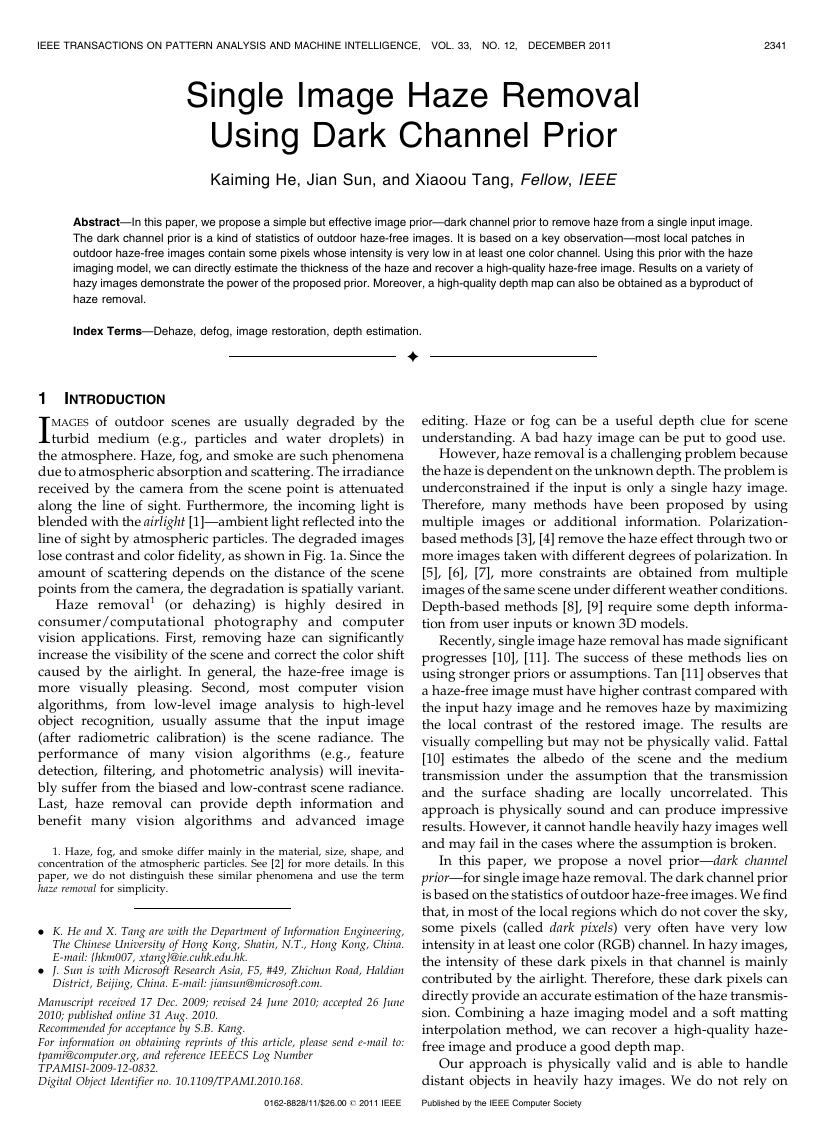
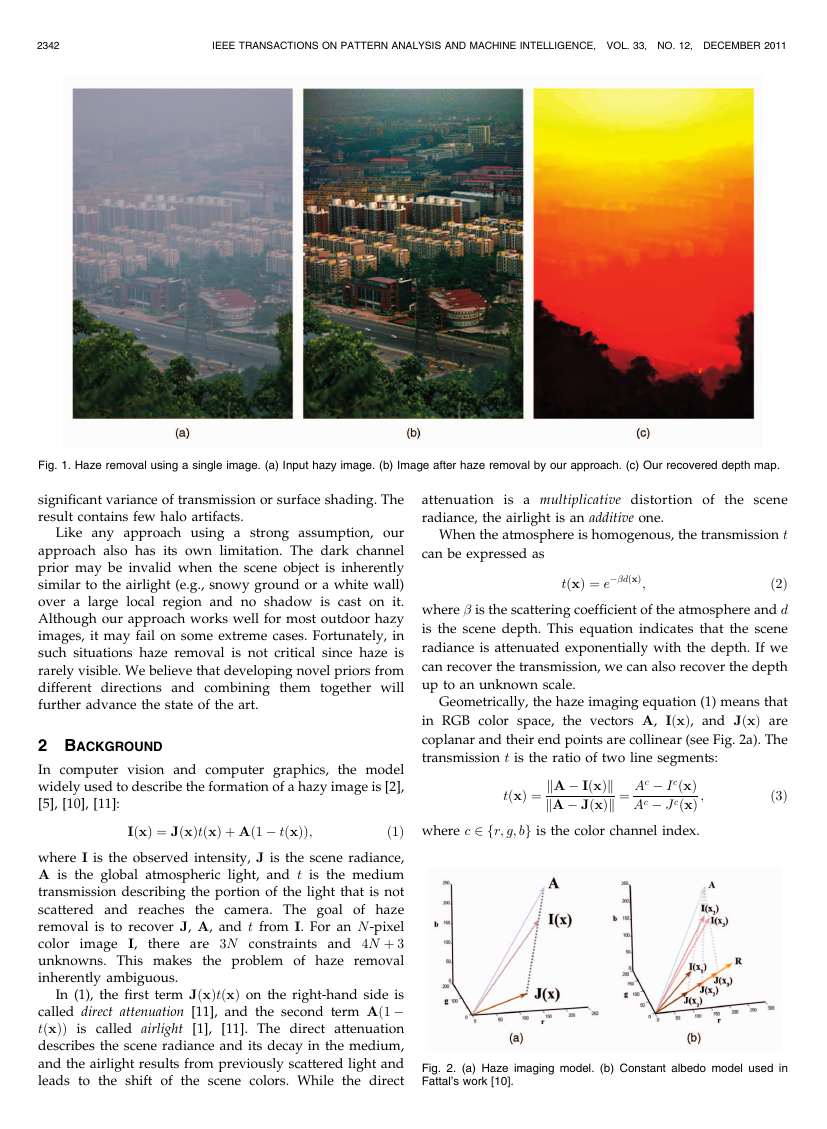
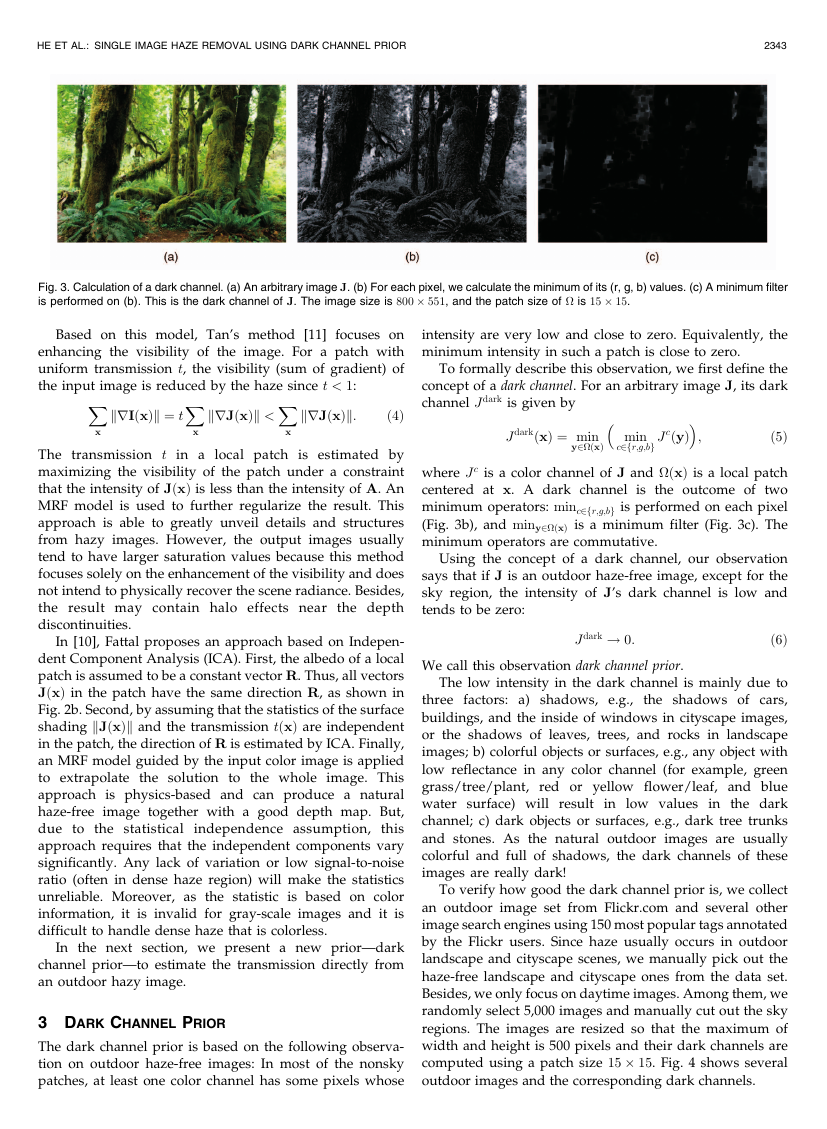

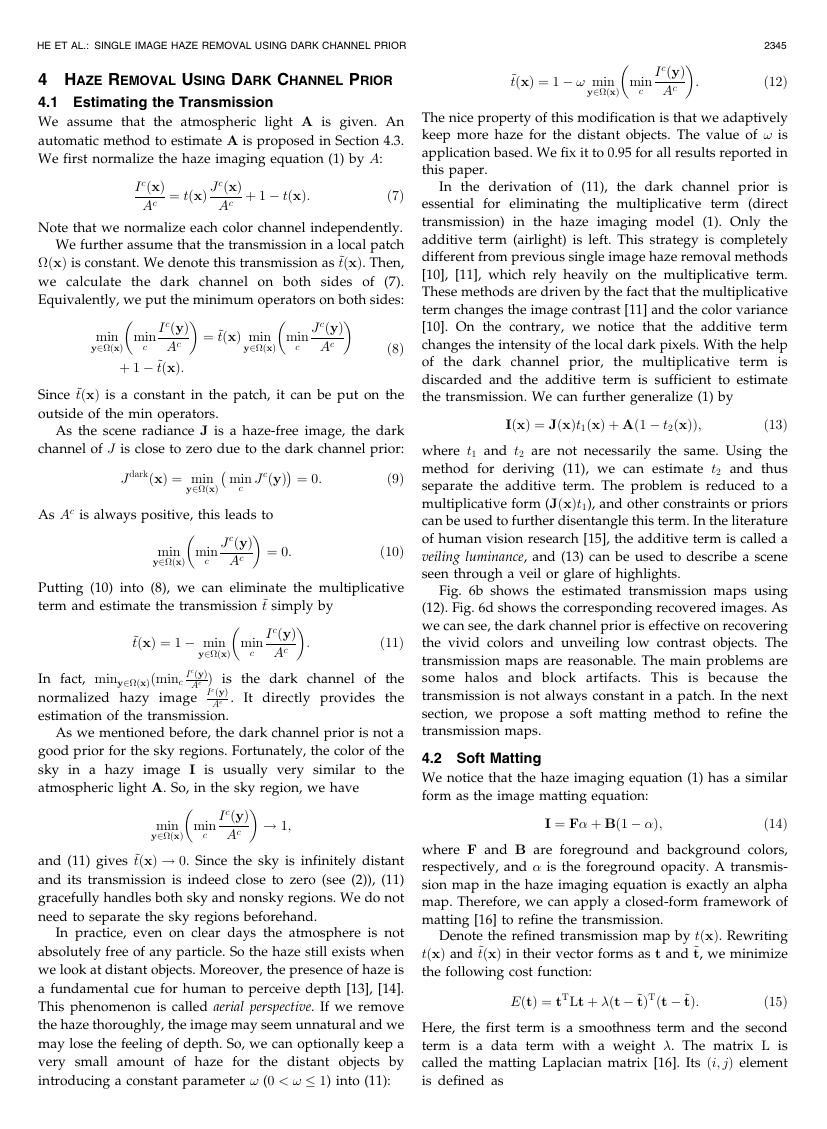

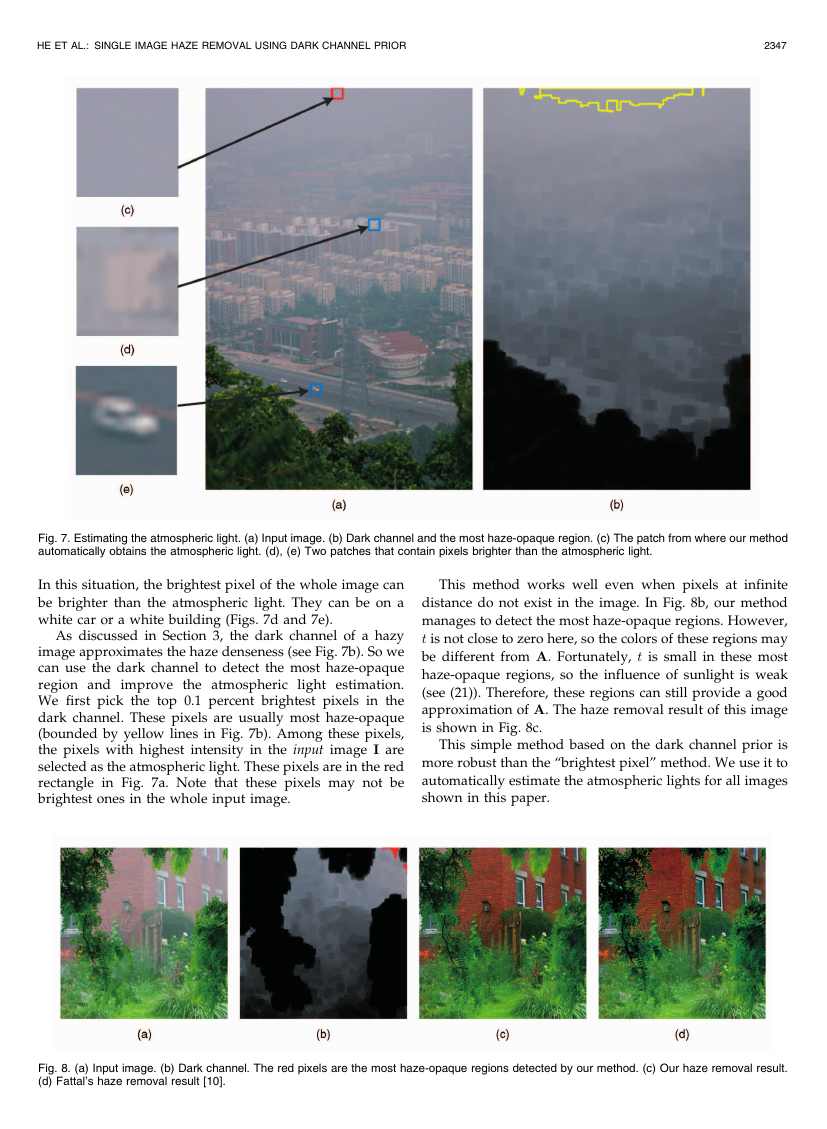
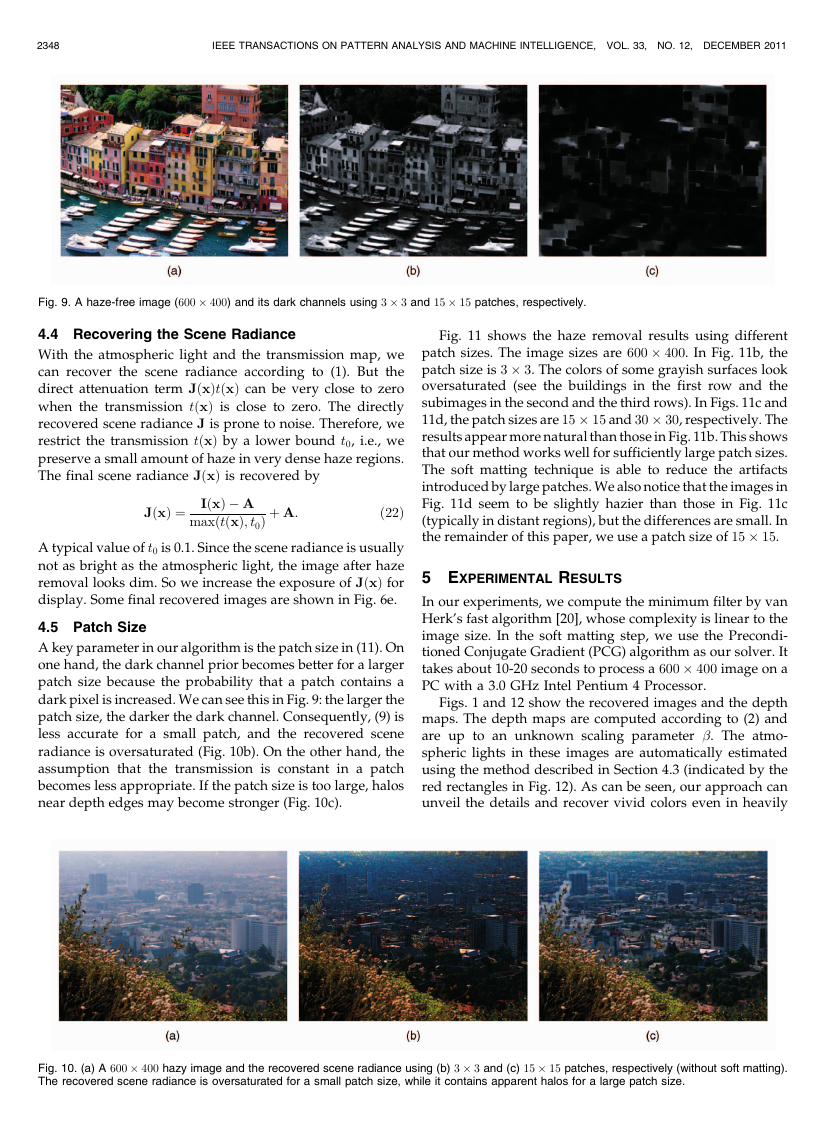








 2023年江西萍乡中考道德与法治真题及答案.doc
2023年江西萍乡中考道德与法治真题及答案.doc 2012年重庆南川中考生物真题及答案.doc
2012年重庆南川中考生物真题及答案.doc 2013年江西师范大学地理学综合及文艺理论基础考研真题.doc
2013年江西师范大学地理学综合及文艺理论基础考研真题.doc 2020年四川甘孜小升初语文真题及答案I卷.doc
2020年四川甘孜小升初语文真题及答案I卷.doc 2020年注册岩土工程师专业基础考试真题及答案.doc
2020年注册岩土工程师专业基础考试真题及答案.doc 2023-2024学年福建省厦门市九年级上学期数学月考试题及答案.doc
2023-2024学年福建省厦门市九年级上学期数学月考试题及答案.doc 2021-2022学年辽宁省沈阳市大东区九年级上学期语文期末试题及答案.doc
2021-2022学年辽宁省沈阳市大东区九年级上学期语文期末试题及答案.doc 2022-2023学年北京东城区初三第一学期物理期末试卷及答案.doc
2022-2023学年北京东城区初三第一学期物理期末试卷及答案.doc 2018上半年江西教师资格初中地理学科知识与教学能力真题及答案.doc
2018上半年江西教师资格初中地理学科知识与教学能力真题及答案.doc 2012年河北国家公务员申论考试真题及答案-省级.doc
2012年河北国家公务员申论考试真题及答案-省级.doc 2020-2021学年江苏省扬州市江都区邵樊片九年级上学期数学第一次质量检测试题及答案.doc
2020-2021学年江苏省扬州市江都区邵樊片九年级上学期数学第一次质量检测试题及答案.doc 2022下半年黑龙江教师资格证中学综合素质真题及答案.doc
2022下半年黑龙江教师资格证中学综合素质真题及答案.doc